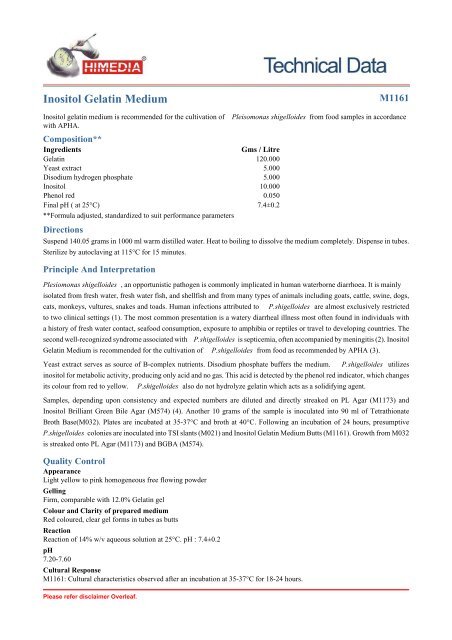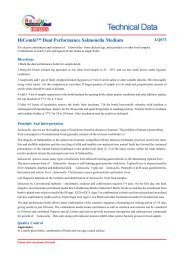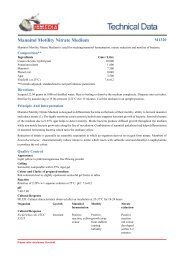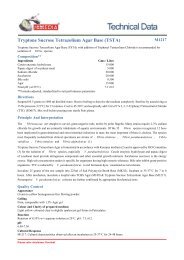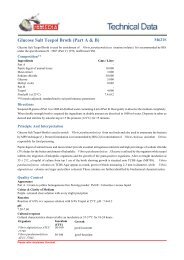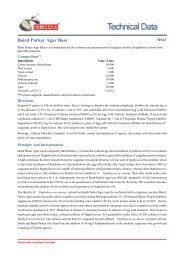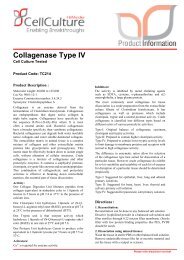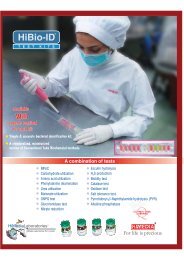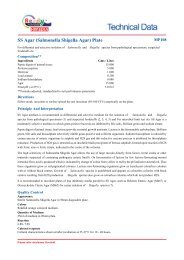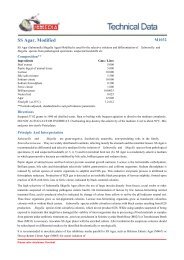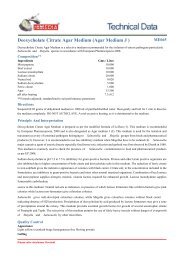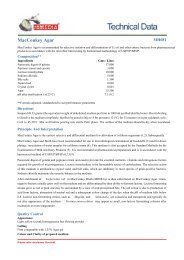Inositol Gelatin Medium - HiMedia Laboratories
Inositol Gelatin Medium - HiMedia Laboratories
Inositol Gelatin Medium - HiMedia Laboratories
You also want an ePaper? Increase the reach of your titles
YUMPU automatically turns print PDFs into web optimized ePapers that Google loves.
<strong>Inositol</strong> <strong>Gelatin</strong> <strong>Medium</strong><br />
Please refer disclaimer Overleaf.<br />
M1161<br />
<strong>Inositol</strong> gelatin medium is recommended for the cultivation of Pleisomonas shigelloides from food samples in accordance<br />
with APHA.<br />
Composition**<br />
Ingredients Gms / Litre<br />
<strong>Gelatin</strong> 120.000<br />
Yeast extract 5.000<br />
Disodium hydrogen phosphate 5.000<br />
<strong>Inositol</strong> 10.000<br />
Phenol red 0.050<br />
Final pH ( at 25°C) 7.4±0.2<br />
**Formula adjusted, standardized to suit performance parameters<br />
Directions<br />
Suspend 140.05 grams in 1000 ml warm distilled water. Heat to boiling to dissolve the medium completely. Dispense in tubes.<br />
Sterilize by autoclaving at 115°C for 15 minutes.<br />
Principle And Interpretation<br />
Plesiomonas shigelloides , an opportunistic pathogen is commonly implicated in human waterborne diarrhoea. It is mainly<br />
isolated from fresh water, fresh water fish, and shellfish and from many types of animals including goats, cattle, swine, dogs,<br />
cats, monkeys, vultures, snakes and toads. Human infections attributed to P.shigelloides are almost exclusively restricted<br />
to two clinical settings (1). The most common presentation is a watery diarrheal illness most often found in individuals with<br />
a history of fresh water contact, seafood consumption, exposure to amphibia or reptiles or travel to developing countries. The<br />
second well-recognized syndrome associated with P.shigelloides is septicemia, often accompanied by meningitis (2). <strong>Inositol</strong><br />
<strong>Gelatin</strong> <strong>Medium</strong> is recommended for the cultivation of P.shigelloides from food as recommended by APHA (3).<br />
Yeast extract serves as source of B-complex nutrients. Disodium phosphate buffers the medium. P.shigelloides utilizes<br />
inositol for metabolic activity, producing only acid and no gas. This acid is detected by the phenol red indicator, which changes<br />
its colour from red to yellow. P.shigelloides also do not hydrolyze gelatin which acts as a solidifying agent.<br />
Samples, depending upon consistency and expected numbers are diluted and directly streaked on PL Agar (M1173) and<br />
<strong>Inositol</strong> Brilliant Green Bile Agar (M574) (4). Another 10 grams of the sample is inoculated into 90 ml of Tetrathionate<br />
Broth Base(M032). Plates are incubated at 35-37°C and broth at 40°C. Following an incubation of 24 hours, presumptive<br />
P.shigelloides colonies are inoculated into TSI slants (M021) and <strong>Inositol</strong> <strong>Gelatin</strong> <strong>Medium</strong> Butts (M1161). Growth from M032<br />
is streaked onto PL Agar (M1173) and BGBA (M574).<br />
Quality Control<br />
Appearance<br />
Light yellow to pink homogeneous free flowing powder<br />
Gelling<br />
Firm, comparable with 12.0% <strong>Gelatin</strong> gel<br />
Colour and Clarity of prepared medium<br />
Red coloured, clear gel forms in tubes as butts<br />
Reaction<br />
Reaction of 14% w/v aqueous solution at 25°C. pH : 7.4±0.2<br />
pH<br />
7.20-7.60<br />
Cultural Response<br />
M1161: Cultural characteristics observed after an incubation at 35-37°C for 18-24 hours.
<strong>HiMedia</strong> <strong>Laboratories</strong> Technical Data<br />
Organism<br />
Cultural Response<br />
Inoculum<br />
(CFU)<br />
Growth<br />
Plesiomonas shigelloides<br />
ATCC 14029<br />
50-100 luxuriant<br />
Storage and Shelf Life<br />
Store below 30°C in tightly closed container and prepared medium at 2-8°C. Use before expiry period on the label.<br />
Reference<br />
1.Brenden R. A., Miller M. A., and J. M., Janda, 1988, Rev. Infect. Dis. 10:303-316<br />
2.Murray P. R., Baron J. H., Pfaller M. A., Jorgensen J. H. and Yolken R. H., (Eds.), 2003, Manual of Clinical Microbiology,<br />
8th Ed., American Society for Microbiology, Washington, D.C.<br />
3.Downes F. P. and Ito K., (Eds.), 2001, Compendium of Methods for the Microbiological Examination of Foods, 4th Ed.,<br />
APHA, Washington, D.C.<br />
4.Miller M. L and Koburger J. A., 1985, J. Food Prot., 48:449.<br />
Disclaimer :<br />
Revision : 1 / 2011<br />
User must ensure suitability of the product(s) in their application prior to use. Products conform solely to the information contained in<br />
this and other related <strong>HiMedia</strong> publications. The information contained in this publication is based on our research and development<br />
work and is to the best of our knowledge true and accurate. <strong>HiMedia</strong> <strong>Laboratories</strong> Pvt Ltd reserves the right to make changes to<br />
specifications and information related to the products at any time. Products are not intended for human or animal or therapeutic use but<br />
for laboratory,diagnostic, research or further manufacturing use only, unless otherwise specified. Statements contained herein should not<br />
be considered as a warranty of any kind, expressed or implied, and no liability is accepted for infringement of any patents.<br />
<strong>HiMedia</strong> <strong>Laboratories</strong> Pvt. Ltd. A-516,Swastik Disha Business Park,Via Vadhani Ind. Est., LBS Marg, Mumbai-400086, India. Customer care No.: 022-6147<br />
1919 Email: techhelp@himedialabs.com


